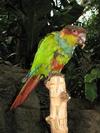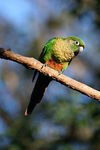Genus Pyrrhura
White-necked Conure - Its natural habitat is subtropical or tropical moist montanes. It is threatened by habitat loss.
Ochre-marked parakeet - One of the largest among Pyrrhura parakeets, the Ochre-marked Parakeet is endemic to lowland humid forests of coastal areas of southeastern Brazil. The diet consists mainly of tree-fruits, seeds, flowers and berries. It nests in a tree cavity. The female usually lays between two to four eggs.
Blaze-winged Parakeet - The Blaze-winged Parakeet , more commonly known as the Blaze-winged Conure in aviculture, is a species of parrot found in wooded habitats in the Pantanal-region of Brazil and Paraguay. It remains locally fairly common, but has suffered due to extensive habitat destruction within its relatively small range, and has therefore been uplisted to Near Threatened by BirdLife International in 2009. The type specimen is labelled Bolivia, but due to shifting borders it is now believed to be from Paraguay. It has often been considered a subspecies of the Maroon-bellied Parakeet based on apparent hybrids from Paraguay, but – as far as known – the two generally maintain their integrity, and are therefore considered separate species by all major authorities today. They resemble each other, but the Blaze-winged Parakeet has a dusky crown and red "shoulder" and underwing coverts.
Fiery-shouldered Parakeet - It is found in Brazil, Guyana, and Venezuela. Its natural habitat is subtropical or tropical moist montane forests.
Maroon-bellied Parakeet - The Maroon-bellied Parakeet is a small parrot found from southeastern Brazil to north-eastern Argentina, including eastern Paraguay and Uruguay. It is also known as the Reddish-bellied Parakeet, and in aviculture it is usually referred to as the Maroon-bellied Conure, Reddish-bellied Conure or Brown-eared Conure.
Grey-breasted Parakeet - The Grey-breasted Parakeet is a species of parrot in the family Psittacidae. It is endemic to Ceará in north-eastern Brazil and restricted to a few mountains with relatively humid forest and woodland in a region otherwise dominated by arid Caatinga.
Red-eared Conure - Its natural habitats are subtropical or tropical moist montanes and heavily degraded former forest.
Sulphur-winged Parakeet - The Sulphur-winged Parakeet is 23 cm long and weighs 75 g. The adult is mainly green. Scaled with orange-yellow on the head and chest. There is a red spot on the auriculars and the tail is broadly tipped dull red . The outer primaries are blue, but the most obvious feature in flight is the extensive yellow on the inner wing. Young birds are similar to the adults, but duller and with much less yellow in the wing.
Pearly Parakeet - The Pearly Parakeet , more commonly known as the Pearly Conure in aviculture, is a species of parrot that is endemic to east Amazonian forests in Brazil. Its taxonomic history is potentially confusing. It was formerly known as Pyrrhura perlata, but following a review it was discovered that the type specimen, long believed to belong to this species, actually was a juvenile of the closely related Crimson-bellied Parakeet. Consequently, P. perlata was transferred to that species, while the next name in line for the Pearly Parakeet, P. lepida, became its valid scientific name. While the Pearly Parakeet remains locally fairly common, it has suffered due to extensive habitat destruction, especially in the eastern part of its range where the subspecies coerulescens may be approaching extinction.
White-eared Parakeet - It is 21-22 centimetres long. The plumage is mostly green with black and white scaling on the breast and a dark-red belly and rump. The face and throat are chestnut, the forehead is bluish and there is a white ear-patch. The long, graduated tail has a red underside. The bird has a sharp call which is repeated three or four times.
Maroon-tailed Parakeet - Its natural habitats are subtropical or tropical moist lowland forests and subtropical or tropical moist montane forests. It is not considered a threatened species by the IUCN.
Green-cheeked Parakeet - The Green-cheeked Parakeet is 26 cm long and weighs 60 to 80 g. It is mainly green, with a brown/black/grey crown, white bare eye-rings, green cheeks, blue primary wing feathers, a grey beak, and its long pointed tail is mostly maroon. It has short transverse striations on its breast and a red abdominal area. Males and females have an identical external appearance.
El Oro Parakeet - The body is mostly covered by a darkish green color with a red forehead . The edges of the wings, and the end of the tail, also have this same red color. On the outer edges of the wings, there is a bluish color. Feet are dark grey, the eyes are surrounded by a white circle and the bill is horn colored. It is approximately 22cm long and weighs 73g.
Crimson-bellied Parakeet - The Crimson-bellied Parakeet , more commonly known as the Crimson-bellied Conure in aviculture, is a species of parrot in the Psittacidae family. It is found in forests in the south-central Amazon Basin in Brazil and Bolivia. It remains locally fairly common, and is consequently considered to be of least concern by BirdLife International and IUCN. Its taxonomic history is potentially confusing. It was formerly known as Pyrrhura rhodogaster, but following a review it was discovered that the type specimen for P. perlata, long believed to belong to the closely related Pearly Parakeet, actually was a juvenile Crimson-bellied Parakeet. Consequently, P. perlata was transferred to this species, while P. rhodogaster became a junior synonym.
Pfrimer's parakeet - The Pfrimer's Parakeet , in aviculture also known as Pfrimer's Conure, is a species of parrot in the family Psittacidae. It is endemic to Goiás and Tocantins in Brazil. It is restricted to deciduous and semi-deciduous Caatinga forest.
Painted Parakeet - Traditionally, the Painted Parakeet included the Santarém Parakeet , Bonaparte's Parakeet and Rose-fronted Parakeet as subspecies. Following a review in 2002, it was recommended treating these as separate species. Following this treatment, the Painted Parakeet includes the following subspecies:
Rose-headed Parakeet - Its natural habitats are subtropical or tropical moist montanes and heavily degraded former forest.
Black-capped Parakeet - It lives in humid forests, ranging from the Amazonian lowlands up to an altitude of 2000 m. on the East Andean slopes. While its habitat is being disturbed, parts of its range are within protected areas , and it remains widespread and locally fairly common. Flock size 20-30, smaller in breeding season.
Santa Marta Conure - Its natural habitat is subtropical or tropical moist montane forests. It is threatened by habitat loss.



